
Switzerland - Rhätische Bahn RhB
For a full scale picture, please click on the picture shown !
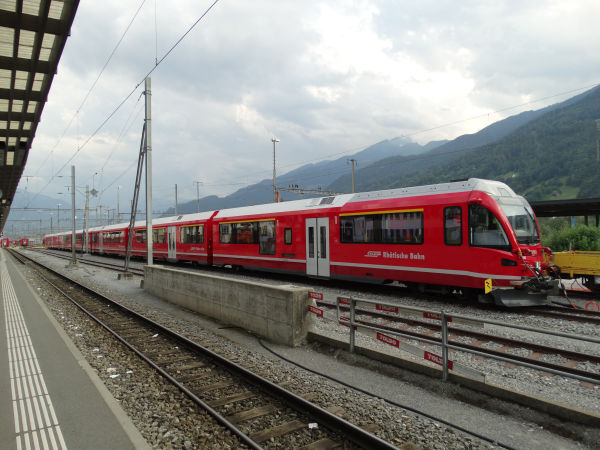
RhB or Rhätische Bahn or Viafier retica, Ferrovia retica, the railroad of Kanton Grischona (Graubünden) is Europe´s biggest
network of narrow gauge railroads. The base network is 376 km long, electrified with 11 kV AC, 16,7 Hz and has a gauge width
of 1 metre. It was opened for traffic 1889. In addition to the basic network RhB has also other, smaller networks: the
Berninabahn, also 1 metre wide, but electrified with 1 kV DC, the Chur-Arosa line (1 metre, earlier 2 kV DC, now converted to 11kV AC)
and also a minor line from Bellinzona (1 metre, 1,5 kV DC). RhB has about 60 locomotives and numerous EMUs and it operates some
of the most famous mountain railroads of the world. Names like Glacier Express or Bernina Express have been widely known for
decades and also the newer "Rollende Landstrasse" through-the-mountains service of the Vereina tunnel line has rapidly gained
popularity and fame.
This is one of the most modern train compositions of the Rhätische Bahn. This fixed set of coaches is called ALVRA. It's a permanently
coupled set of coaches which is always led by either a Ge 4/4 III locomotive or an Allegra EMU ABe 8/12 at the other end. At the end
shown here is always a permanently coupled new steering cab coach which very much looks like the Allegra trains. Both these new wagon-sets
as well as the fairly new Allegra electric multiple units are made by Stadler.
Picture from Landquart 4.7.2019 by Ilkka Siissalo.
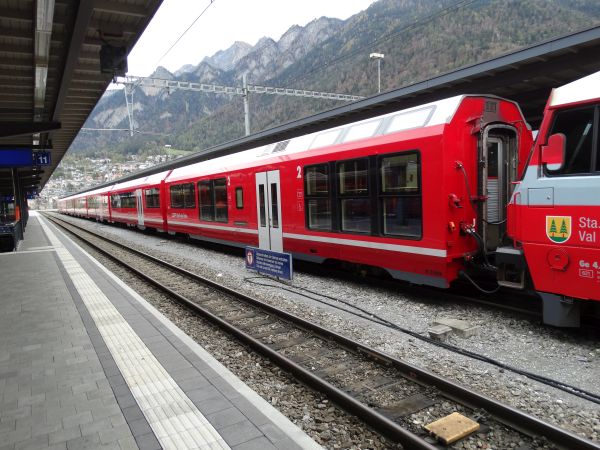
Another one of the new Alvra coach compositions, now seen from the side of the locomotive.
Picture from Chur 3.11.2022 by Ilkka Siissalo.
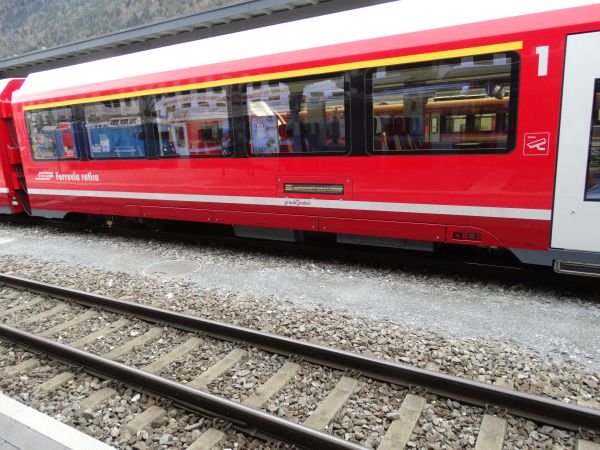
A first class coach of the same Alvra composition as shown above.
Picture from Chur 3.11.2022 by Ilkka Siissalo.
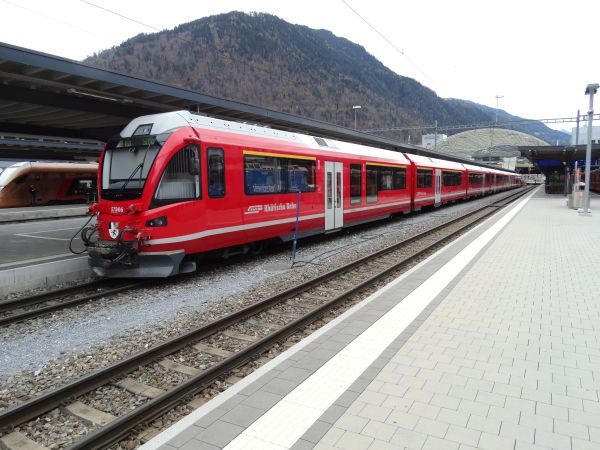
The same Alvra composition as above, but seen from the other end.
Picture from Chur 3.11.2022 by Ilkka Siissalo.
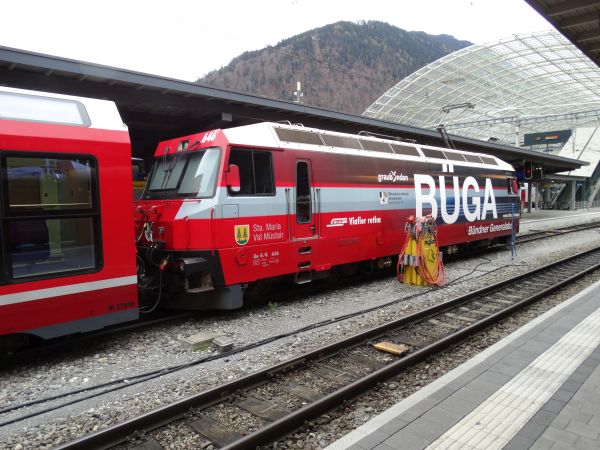
...and this Ge 4/4 III locomotive was the power pack at the other end of this same Alvra composition.
Picture from Chur 3.11.2022 by Ilkka Siissalo.
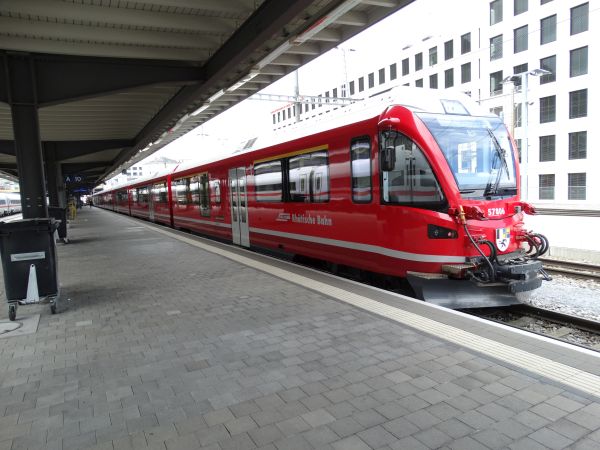
Another Alvra wagonset waiting for its departure time towards St.Moritz at Chur main station. At the end of
this long train there was a Ge 4/4 III locomotive.
Picture from Chur 14.5.2023 by Ilkka Siissalo.
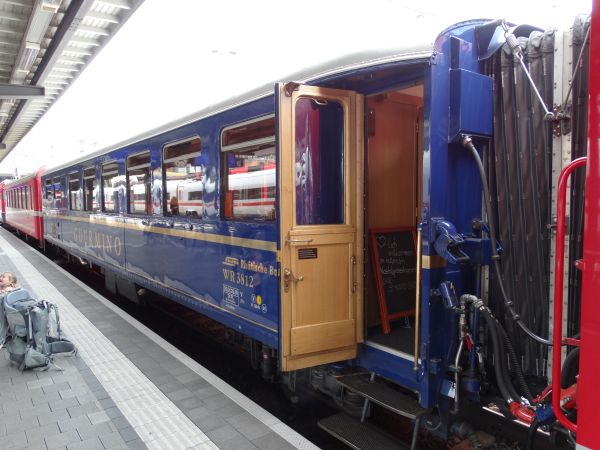
Between the modern Alvra wagonset shown above and the Ge 4/4 III locomotive, there was this very old, very exclusive and very expensive restaurant
wagon "Gourmino" no. WR 3812 plus also one older RhB normal passenger coach.
Picture from Chur 14.5.2023 by Ilkka Siissalo.
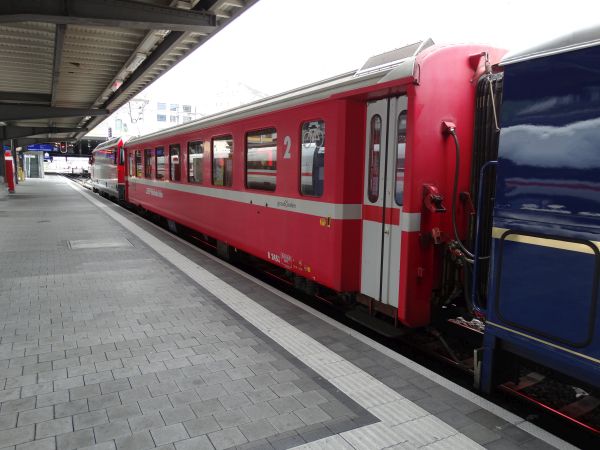
...and this was the normal passenger coach which was placed between the locomotive and the Gourmino wagon shown above. This one is B 2450, an FFA EW II
coach from a 40 coaches long series built 1976-80. This kind of extra wagons are often added to RhB's trains which are normally composed of just an Alvra
wagonset in case somebody (or some company) wants to reserve a whole coach. That is quite common practise in Switzerland.
Picture from Chur 14.5.2023 by Ilkka Siissalo.
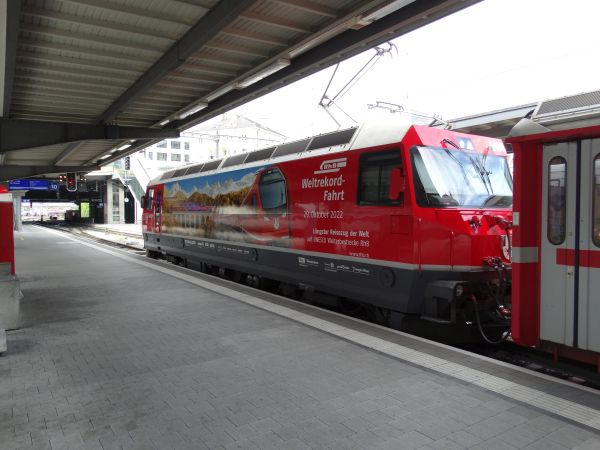
...and this was finally the locomotive pulling this same long train to St.Moritz. It is a Ge 4/4 III with stickers commemorating how RhB in 2022 built
a world's longest passenger train out of Stadler Capricorn units.
Picture from Chur 14.5.2023 by Ilkka Siissalo.
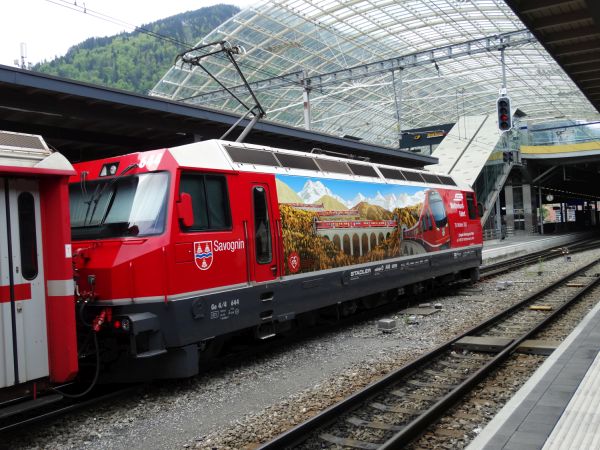
The locomotive class Ge 4/4 III is the newest mainline locomotive type of Rhätische Bahn. 12 machines were built between 1993 and 1999.
Its top speed is 100 km/h and power rating is 3100 kW. And as well known, the voltage on the RhB main lines is 11 kV AC 16,7 Hz.
These machines are mainly used in the car transportation trains at the Vereina tunnel and then also at passenger trains which use
the long new Alvra wagonsets on RhB's main lines.
Picture from Chur 14.5.2023 by Ilkka Siissalo.
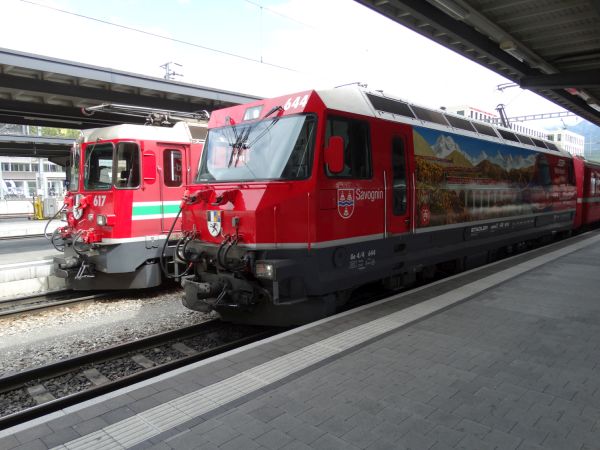
...and still a good frontal view of the same Ge 4/4 III no.644.
Picture from Chur 14.5.2023 by Ilkka Siissalo.

Rhätische Bahn has replaced most of their mainline locomotive powered trains now by these electric multiple units called Stadler Capricorn.
Capricorn is a four coaches long EMU and they are typically now used in 2x4 or 3x4 compositions. Here a single Capricorn unit has just
arrived at Chur and is soon ready to leave towards Thusis as a Regionalexpress.
Picture from Chur 14.5.2023 by Ilkka Siissalo.
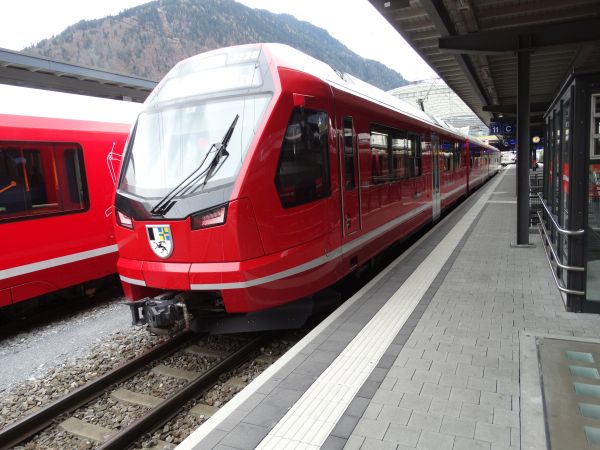
This is one of RhB's new Capricorn EMU trains, no.3128, here just leaving from Chur towards Rhäzüns. RhB ordered a large series of these four coach
EMUs and has actually replaced most of their locomotive powered passenger coach trains with these ones. These are made by Stadler.
Picture from Chur 3.11.2022 by Ilkka Siissalo.
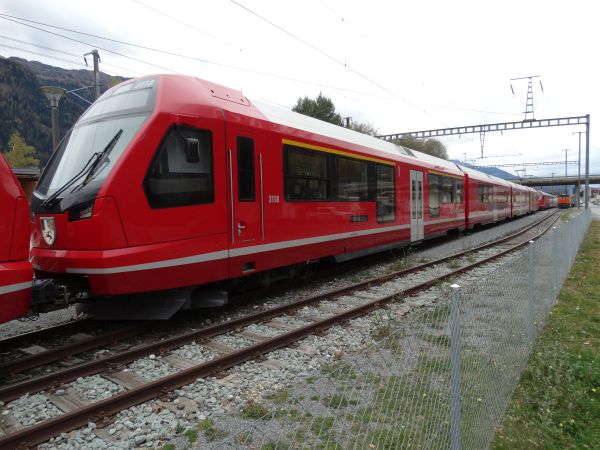
Another Stadler Capricorn EMU train. Rhätische Bahn created during the late autumn of 2022 a new world record by building and driving the world's
longest passenger train - and that on metre gauge narrow gauge tracks!!. It was entirely composed of these new Capricorn units and the record train
was over 1,9 km long. Afterwards the record train was split up and Capricorn units that had been part of it were parked where ever there was suitable
empty space. This small station of Felsberg got a piece of the record train consisting of five parked Capricorn units, four coaches each. All the
neighbouring stations got their pieces as well. At the point of time when this picture was taken, most of the Capricorns had not yet been taken
into commercial use and the only task that they had so far had was to be a part of the world record train.
Picture from Felsberg near Chur 3.11.2022 by Ilkka Siissalo.

A part of the world record train, the Capricorn unit 3119 on the left and 3118 just to the right of the picture. And there is a third Capricorn
also which can be barely seen between these two units, just stopping at Felsberg and taking up passengers. That one was already in active use.
Picture from Felsberg near Chur 3.11.2022 by Ilkka Siissalo.
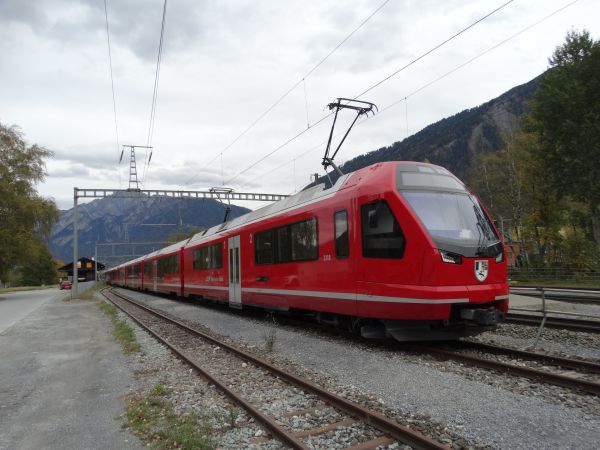
A part of the world record train, Capricorn units 3118 (in front) and 3119 behind. Another piece of the record train, consisting of further three
Capricorns was behind me when I took the photo.
Picture from Felsberg near Chur 3.11.2022 by Ilkka Siissalo.
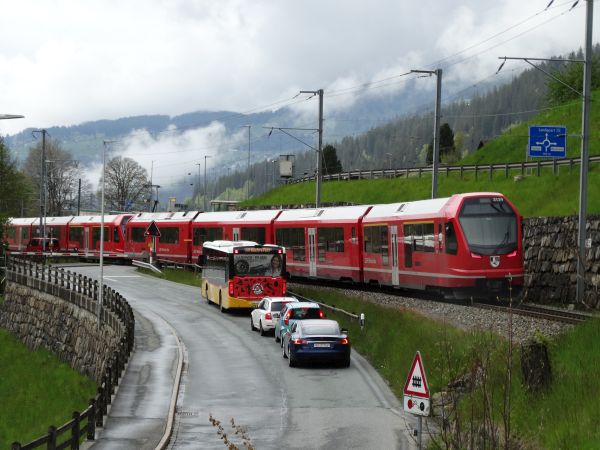
An InterRegio train composed of two Capricorn EMU units on its way from Davos down towards Landquart.
Picture from Serneus near Klosters 14.5.2023 by Ilkka Siissalo.
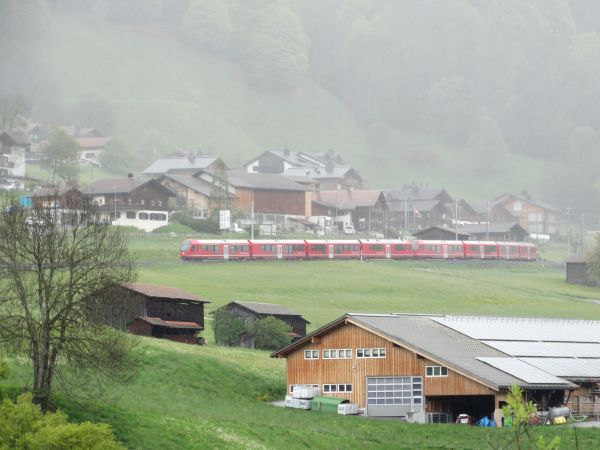
The same train as shown above, here just passing the village of Klosters inside a cloud.
Picture from Klosters 14.5.2023 by Ilkka Siissalo.
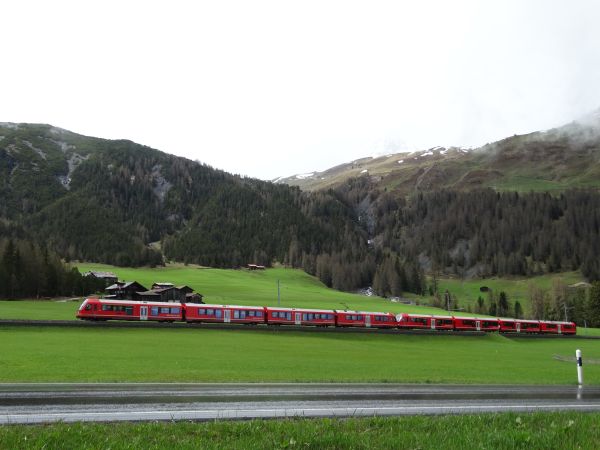
This is the same train as shown in the previous two pictures, but this picture has been taken about an hour earlier as the train
was coming from Landquart and climbing uphills towards Davos.
Picture was taken from a bus stop called Ober Laret close to Davos 14.5.2023 by Ilkka Siissalo.
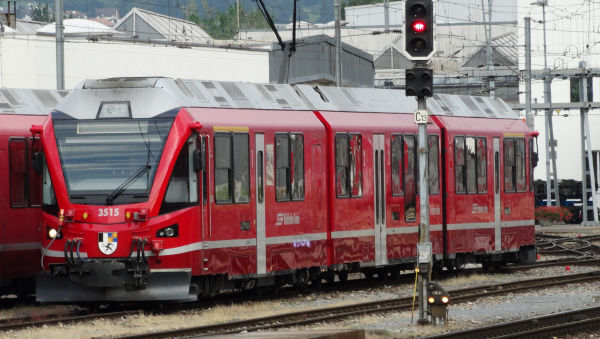
This train is the famous Allegra or ABe 8/12. It is a Stadler-built EMU which can run both on 11 kV 16.7 Hz, as well as on the Bernina Railway,
which is electrified at 1,000 V DC. They are used on the Chur to Arosa line, the Landquart to Davos line and on the Bernina railway. It was
the first truly modern EMU train of the RhB railway system built in the 2000s. 15 trains were built.
Picture from Landquart 4.7.2019 by Ilkka Siissalo.
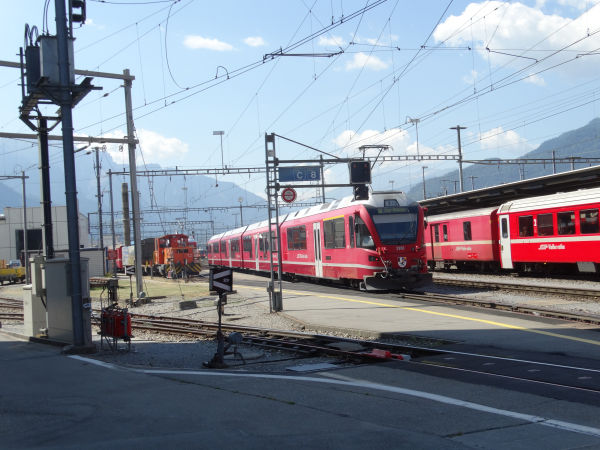
Another Allegra unit no. 3101 ready to leave towards Rhäzüns. Note that this Allegra unit is four coaches long. Some others are just three coaches
long trains. Allegra trains exist both as three coach and four coach compositions (ABe 8/12 and ABe 8/16). This 3101 is one of the four
coaches long ABe 8/16 units. Only five trains like this were built.
Picture from Landquart in the morning of 5.7.2019 by Ilkka Siissalo.

Almost the same place, almost the same train, but not quite. This is the Allegra unit no.3103 photographed at almost the same spot as the
3101 shown above.
Picture from Landquart in the morning of 5.7.2019 by Ilkka Siissalo.
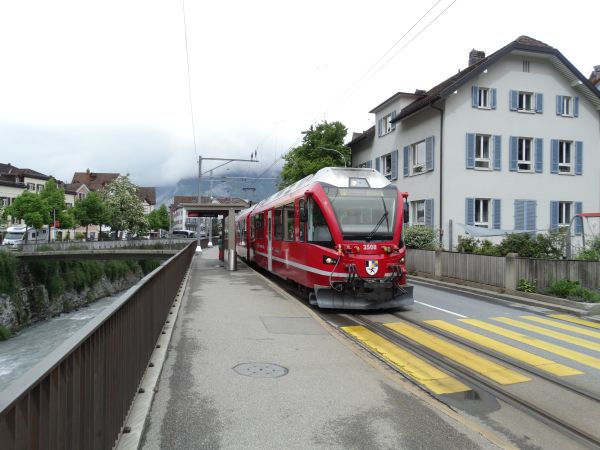
The Rhätische Bahn line from Chur to Arosa runs through the city center of Chur much like a tram and is also stopping on tram-like stops.
This picture is from the train stop Chur-Altstadt (Chur old town). In 2023 these trains to Arosa were no longer hauled by Ge 4/4 II
locomotives (as shown down below) but by three coaches long Allegra EMUs. This was a typical Arosa train: One three coaches long Allegra
plus three older coaches. While it stopped at this train stop at Chur Altstadt it totally blocked all car traffic in a street crossing.
For a long time there have been plans to reroute these trains underground under the city center, but so far it has not happened.
Picture from Chur-Altstadt 14.5.2023 by Ilkka Siissalo.
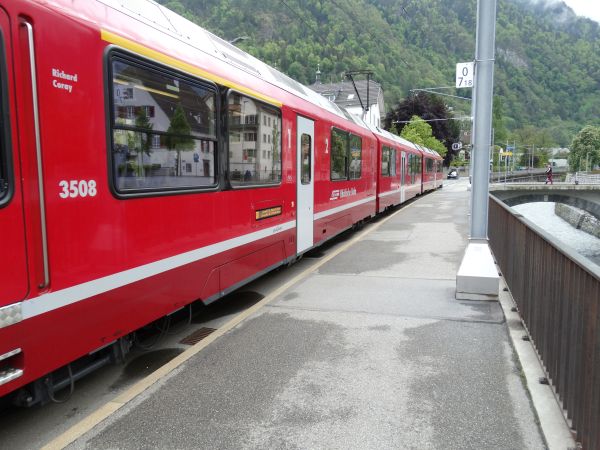
The same train as above. Here it was still slowly moving but about to stop soon. The train driver aimed at stopping the very last coach which
was a low-floor wagon exactly at the tram-stop like train stop. But that meant also that this three coaches long Allegra EMU unit 3508 totally blocked
the street crossing that can be seen here in front.
Picture from Chur-Altstadt 14.5.2023 by Ilkka Siissalo.
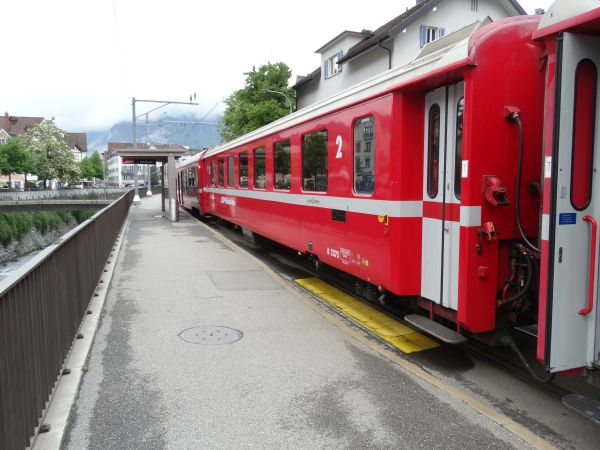
Still the same train as above. The train driver skillfully stopped the very last wagon which was a low-floor coach and where the train conductor
was waiting exactly at the train stop. This train had one modern three coaches long Allegra, then two old coaches dating back to the 1960s and
then as a last wagon a low-floor driver's cab coach.
Picture from Chur-Altstadt 14.5.2023 by Ilkka Siissalo.
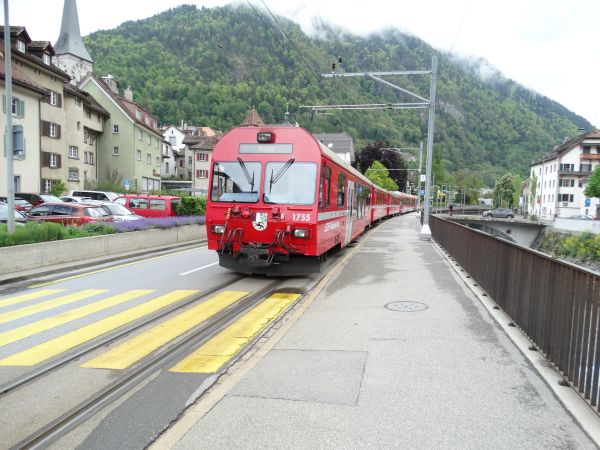
...Now the train had picked up its passengers from the train stop Chur-Altstadt and started moving again. Soon the irritated car drivers can continue...
Picture from Chur-Altstadt 14.5.2023 by Ilkka Siissalo.

...and there it goes now towards Arosa. Train spotter and photographer Matti Heino is documenting from the bridge.
Picture from Chur-Altstadt 14.5.2023 by Ilkka Siissalo.
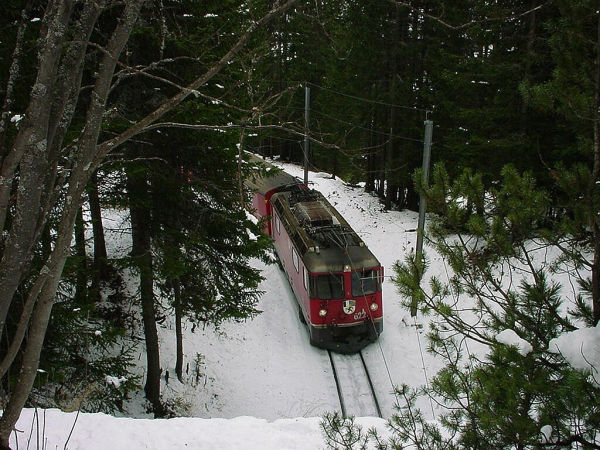
This train is from the Chur to Arosa line and it is here approaching the village of Arosa high up on the mountains. I was walking
with my dog and taking pictures of the dog playing in the fresh snow in the forests
along a small path as I suddenly heard the noice of an approaching train and managed to press the shutter at the right time.
The locomotive is a Ge 4/4 II series no. 622, built in 1984. These Ge 4/4 II´s are the narrow gauge equivalents of the state
SBB´s famous Re 4/4 II, built in 1973 and again in 1984. It´s very similar to the Re 4/4, except for a slightly smaller size,
and the fact that the Ge 4/4 is already based on modern thyristor driven AC motor technology which the SBB counterpart is not.
The engine is 12,96 m long, weighs 50 tons and has a maximum speed of 90 km/h, although at these steep mountain lines speeds in
practise rarely exceed 25 km/h. RhB bought 23 of these engines.
Picture from Arosa in April 2000 by Ilkka Siissalo.
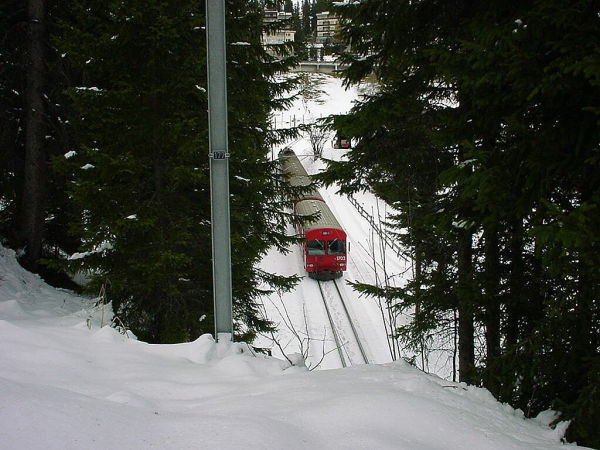
Second view of the train as it has left the small tunnel and approaches Arosa station. Behind the Ge 4/4 II locomotive there were
3 coaches, the last of which is a steering cab coach, no. 1702.
Picture from Arosa in April 2000 by Ilkka Siissalo.
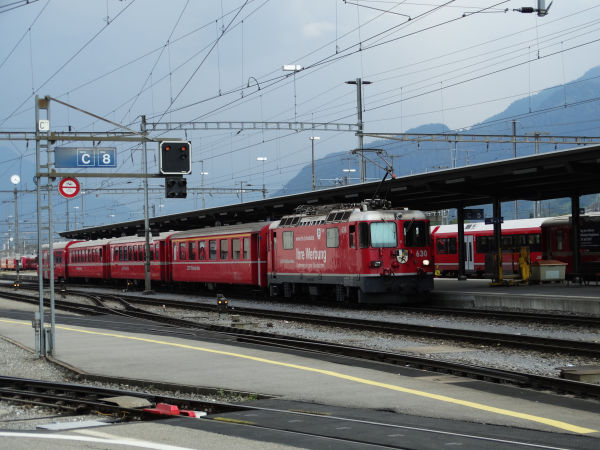
A very typical, although now already old-fashioned Rhätische Bahn express train composition with a Ge 4/4 II locomotive, some express train
coaches and a steering cab coach wagon as the last one. These have been the backbone of the service for a long time. But they are now
gradually being displaced by newer multiple units such as the Allegra and Capricorn.
Picture from Landquart 4.7.2019 by Ilkka Siissalo.
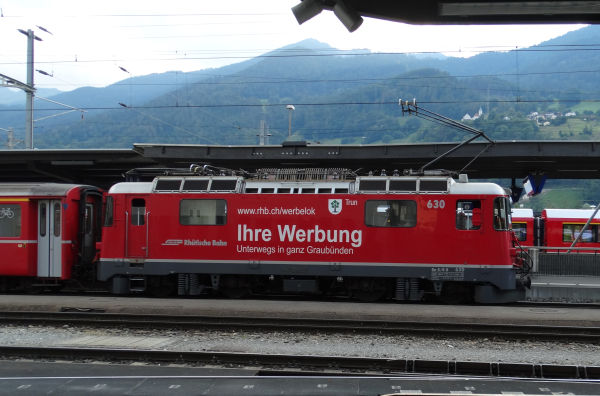
The same Ge 4/4 II locomotive as above, but seen closer by. The text is trying to get you to advertise here on the locomotive. We all hope
you never will :-)
Picture from Landquart 4.7.2019 by Ilkka Siissalo.
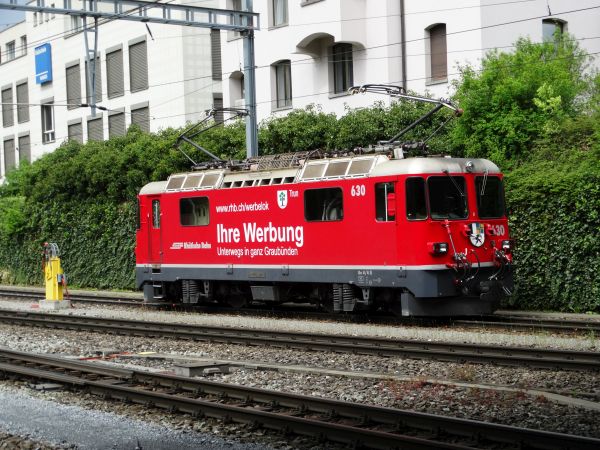
Still the same machine, Ge 4/4 II no.630. Apparently still nobody has wanted to spoil it any further with advertisements. It's still a beautiful
machine.
Picture from Chur 14.5.2023 by Ilkka Siissalo.
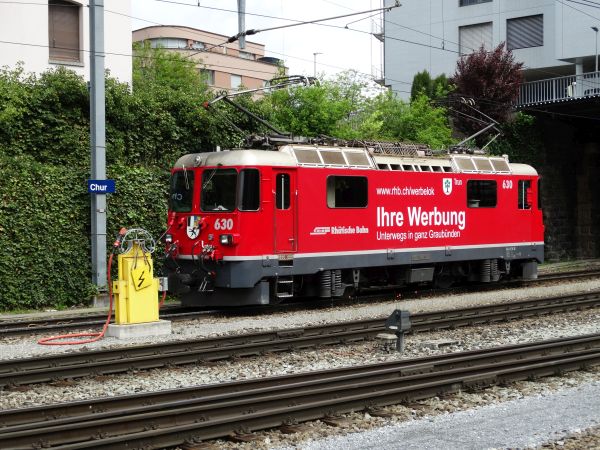
And still one more shot of the same Ge 4/4 II no.630 from a bit different angle.
Picture from Chur 14.5.2023 by Ilkka Siissalo.
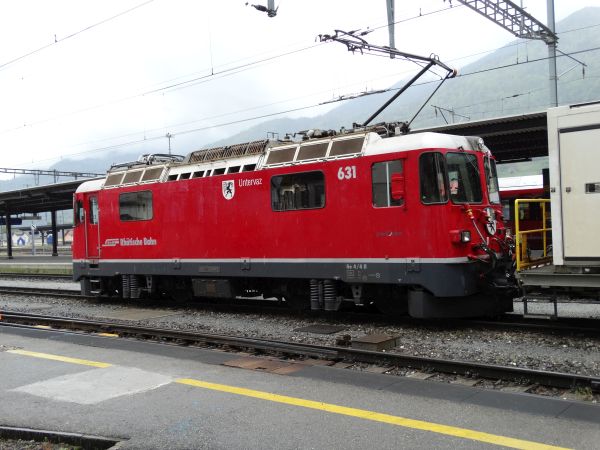
Similar but without any ugly advertisements.
Picture from Landquart 14.5.2023 by Ilkka Siissalo.
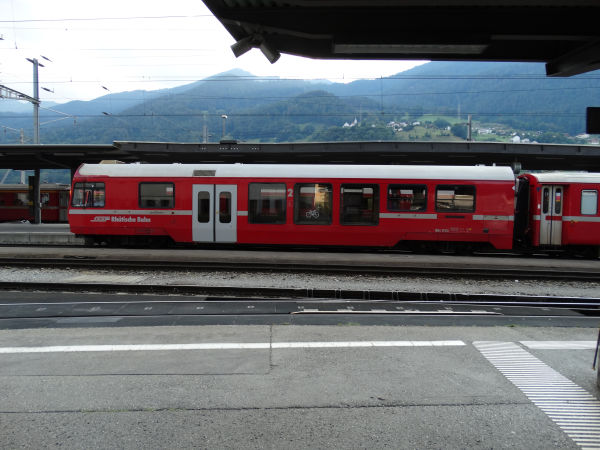
This steering cab coach at the other end of the same train as shown above is a very modern one, with a low-floor compartment, It is
registered as the BDt 1753. This one is from the year 1999 and the basic structure is from Stadler Rail.
Picture from Landquart 4.7.2019 by Ilkka Siissalo.
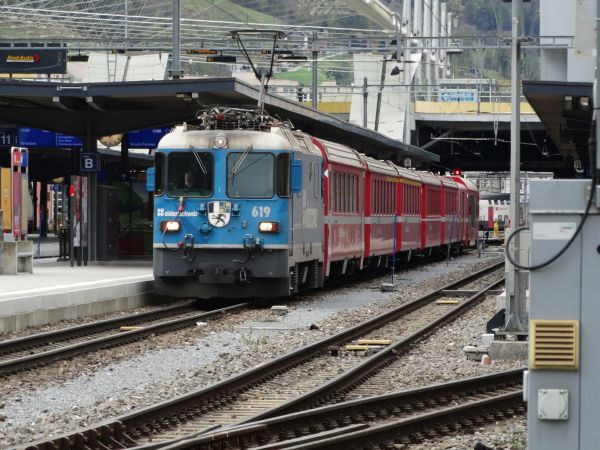
A similar RhB train like the one shown above, with a Ge 4/4 II locomotive (this time with a blue advertisement taping), then a couple of old
passenger coaches and as a last coach a new low-floor one with a driver's cab. The train is just about to leave from Chur towards Scuol-Tarasp.
These trains are probably going to vanish during 2023. They are planned to be replaced by new Capricorn multiple units.
Picture from Chur 3.11.2022 by Ilkka Siissalo.
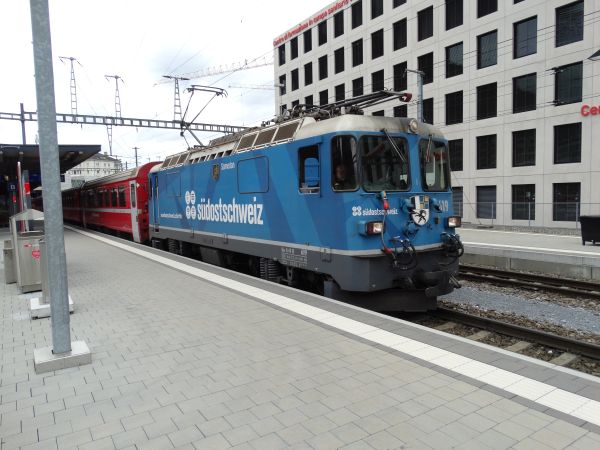
The same Ge 4/4 II locomotive as shown above, now seen more from its side.
Picture from Chur 3.11.2022 by Ilkka Siissalo.

A very traditional - or let's say old-fashioned - postal and cargo coach DS 4225 is here a part of an InterRegio service of RhB from
Chur to St. Moritz.
Picture from Chur station 5.7.2019 by Ilkka Siissalo.
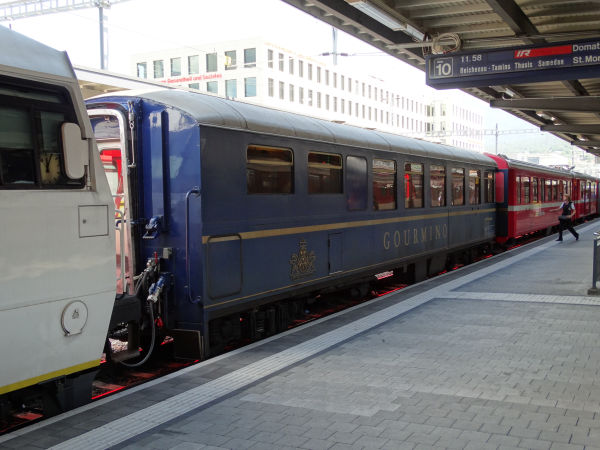
This very exclusive Gourmino restaurant wagon was also part of the same 11.58 service from Chur to St.Moritz as shown above.
Picture from Chur station 5.7.2019 by Ilkka Siissalo.
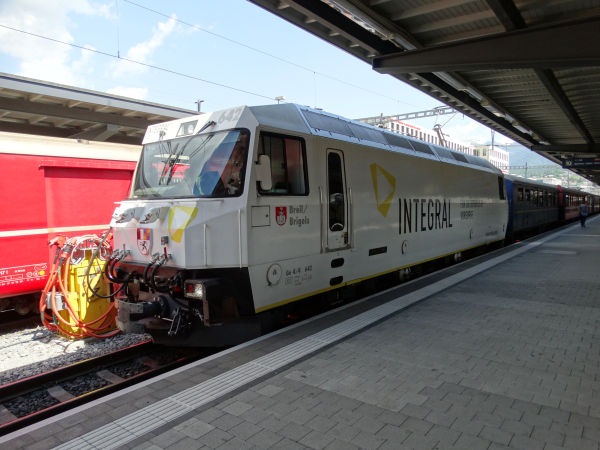
This Ge 4/4 III generation locomotive was leading the same InterRegio train from Chur to St.Moritz where the two coach pictures shown
above were from.
Picture from Chur station 5.7.2019 by Ilkka Siissalo.
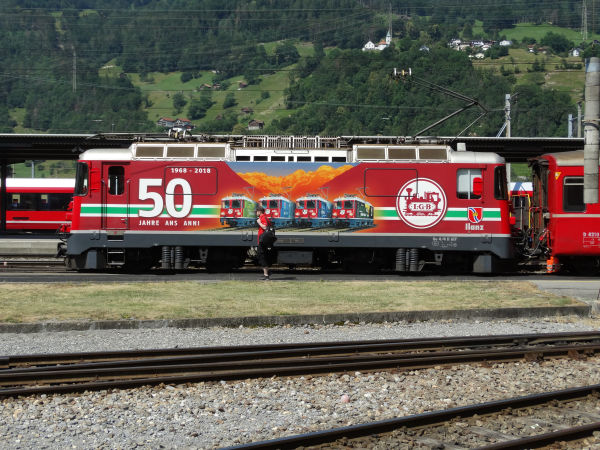
Another one of the Ge 4/4 II locomotives, this no.617 is carrying advertisement tapings of the model train manufacturer LGB. It is typical
of some model train makers that they like to pay for the taping of one or the other locomotive in their own special tapings and then they
make a model of it and sell it in hundreds of copies. And typically the buyers are people who already have that same locomotive - but not
yet precisely in the same special colours. This one is advertising LGB's four model trains of the same type Ge 4/4 II which LGB has made
during its 50 years of operation.
Picture from Landquart 5.7.2019 by Ilkka Siissalo.
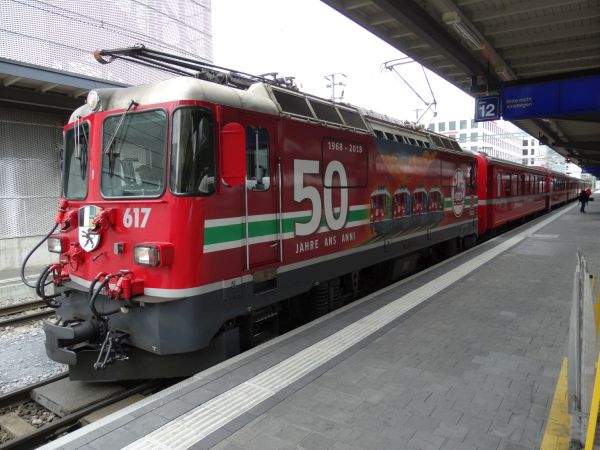
Ge 4/4 II no.617 in Chur in summer 2023. Taking into account that these advertisement tapings of the model railroad brand LGB had been
applied already in 2018 they were in 2023 still in surprisingly good condition.
Picture from Chur 14.5.2023 by Ilkka Siissalo.
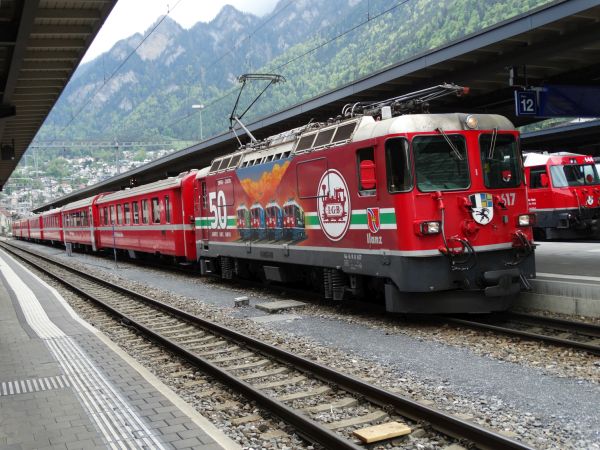
The same Ge 4/4 II no.617 in Chur as shown above, but now seen from the other side.
Picture from Chur 14.5.2023 by Ilkka Siissalo.
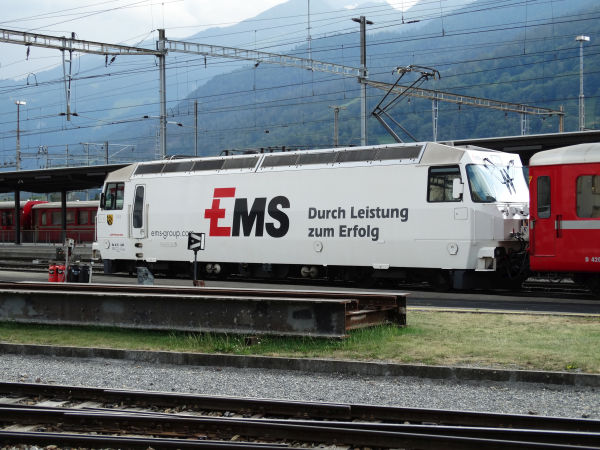
One of Rhätische Bahn's newest and best electric locomotives, the Ge 4/4 III no.643 named after the town of Vals is in fully covering
advertisement tapings, as most of them are. This one advertises for the EMS group, a company working in the field of polymers and specialty chemicals.
Picture from Landquart 4.7.2019 by Ilkka Siissalo.
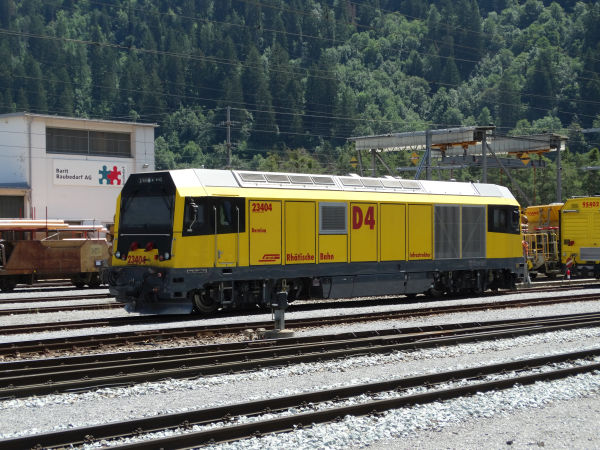
The locomotive number 23404 is one of Rhätische Bahn's newest locomotives. These strong diesel locomotives were ordered from the company Schalker Eisenhütte
in 2009 and taken into use in 2014. They are of the class Gmf 4/4 II. There are four of them in total. It is a four-axle metre gauge main line locomotive
weighing 64 tons and with a maximum speed of 100 km/h and a power rating of 1800 kW. They have diesel engines of the type 12V 4000 R43L of MTU Friedrichshafen
and they are capable of working even at 70 promille steep slopes with their dieselelectric transmission systems. They are used in front of really heavy maintenance
and ballast trains and also during winter time with snow ploughs or rotary ploughs.
Picture from the station of Thusis 5.7.2019 by Ilkka Siissalo.

The same main line diesel locomotive Gmf 4/4 II no.23404 as shown above, but here seen from the other side.
Picture from the station of Thusis 5.7.2019 by Ilkka Siissalo.
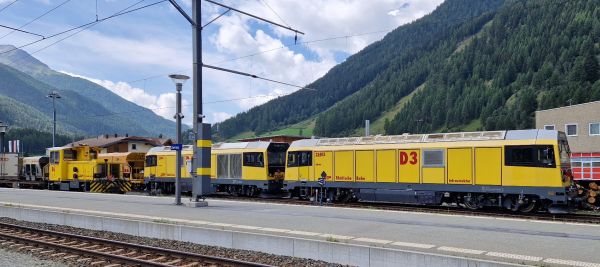
Two of the new, big Gmf 4/4 II diesel locomotives and one small old Tmf 2/2 no 86. The big ones are marked with highly visible markings "D3" and
"D4". D3 is the number 23403 and D4 is the 23404. Note how very different the different sides of these locomotives look like.
Picture from Zernez 21.8.2024 by Matti Heino.
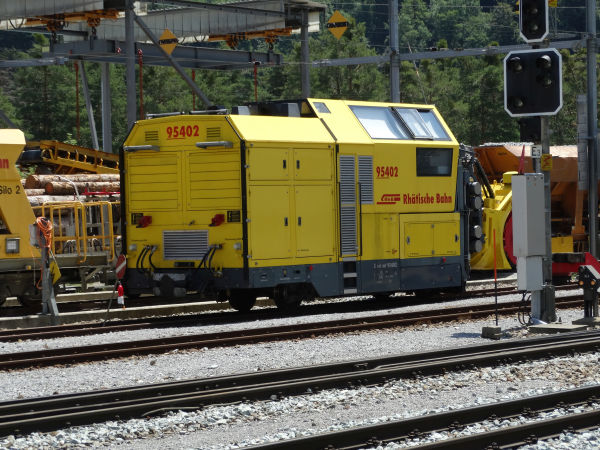
The very modern rotary snow plough Xrot mt 95402 is designed to work together with the new and strong diesel locomotive Gmf 4/4 II shown above.
Picture from the station of Thusis 5.7.2019 by Ilkka Siissalo.

The same rotary snow plough Xrot mt 95402 as above, but here seen from its side. This rotary plough was built by the company Zaugg in 2012. It is today
one of the most effective rotary snow removal engines in the whole of Switzerland.
Picture from the station of Thusis 5.7.2019 by Ilkka Siissalo.
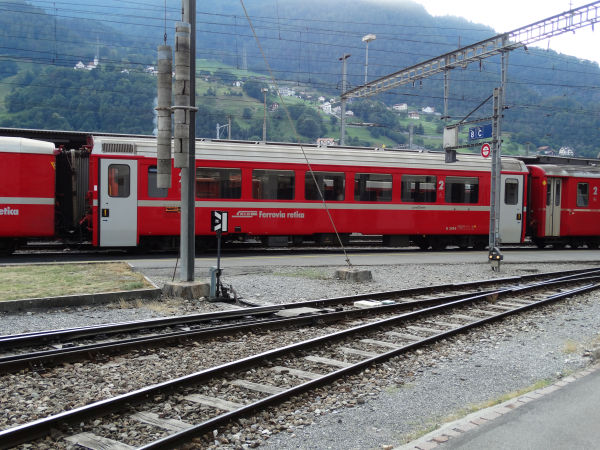
A typical modern Rhätische Bahn express train coach, the B 2494. This design was created for the Berninabahn although the wagons have been used elsewhere
as well, just like here. This precise wagon has been the model for several model train coaches of the scales G and H0e.
Picture from Landquart 4.7.2019 by Ilkka Siissalo.
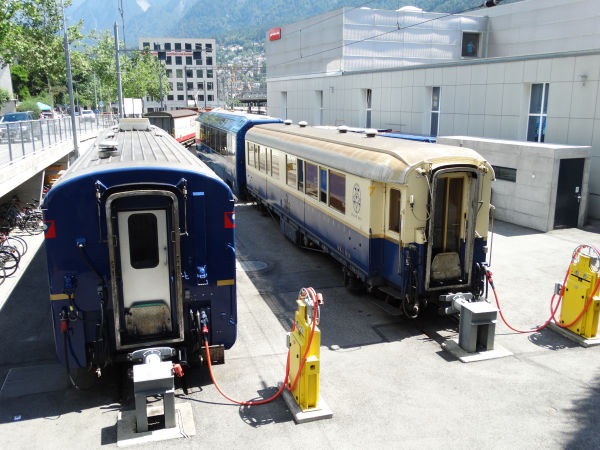
Several different Rhätische Bahn restaurant coaches of various ages parked at a siding where they have constant uninterrupted electricity
available so that their freezers and fridges do not melt.
Picture from a siding at the Chur station 5.7.2019 by Ilkka Siissalo.
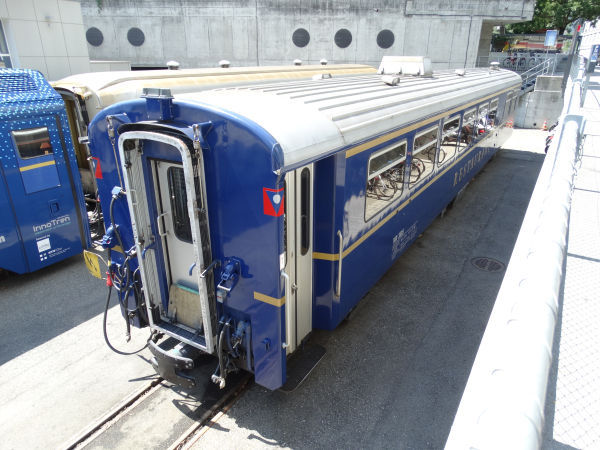
This restaurant wagon fits the style of the 1960s-1970s Chur to Arosa trains' typical coaches.
Picture from a siding at the Chur station 5.7.2019 by Ilkka Siissalo.
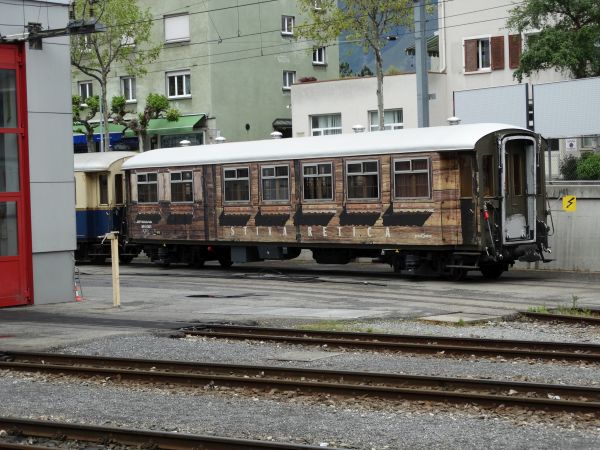
This restaurant wagon A 1208 is really old, it is from the year 1929. It was in 1993 first time covered with sticker tapings trying to make it
look like a centuries old wooden house typical of the Graubünden canton area and it also received the name Stiva Retica, meaning a Rhätian style
beerstube or kind of a traditional local pub. The tapings and wooden interiors have already at least twice been renewed but the old coach still
carries these Stiva Retica colours and is used to offer journeus where passengers can enjoy not only the views but also beer, air dried meat,
mountain cheeses, fondues etc.
An H0 scale model train copy of this Stiva Retica coach is offered in H0m by the model train manufacturer Bemo.
Picture from Chur 14.5.2023 by Ilkka Siissalo.

...and this Stadler made "InnoTren" is for sure the newest that Rhätische Bahn can offer when it comes to restaurant coaches.
Picture from a siding at the Chur station 5.7.2019 by Ilkka Siissalo.
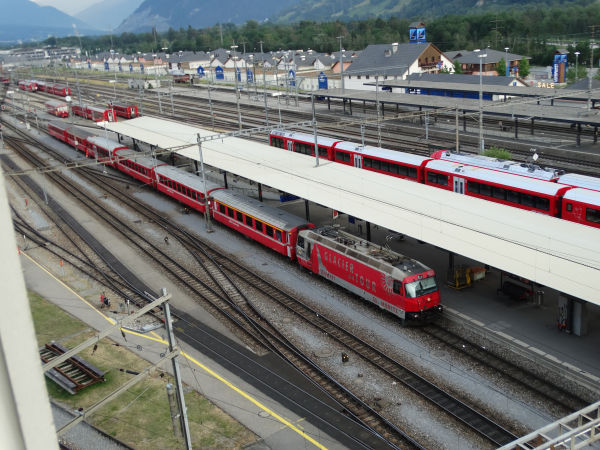
This is still in 2019 a very typical RhB express train running from Landquart to Zermatt, but in the near future this might become a rarity
as EMU type trains are pushing these traditional locomotive + coaches type of trains out of service. Here we have an Ge 4/4 III locomotive with
a long rake of older wagons arriving at Landquart in the evening of 4.7.2019.
Picture from Landquart 4.7.2019 by Ilkka Siissalo.
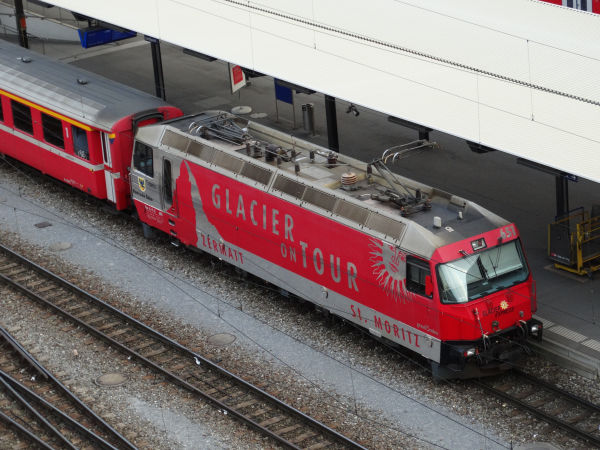
Another view of the same Ge 4/4 III locomotive as shown above.
Picture from Landquart 4.7.2019 by Ilkka Siissalo.
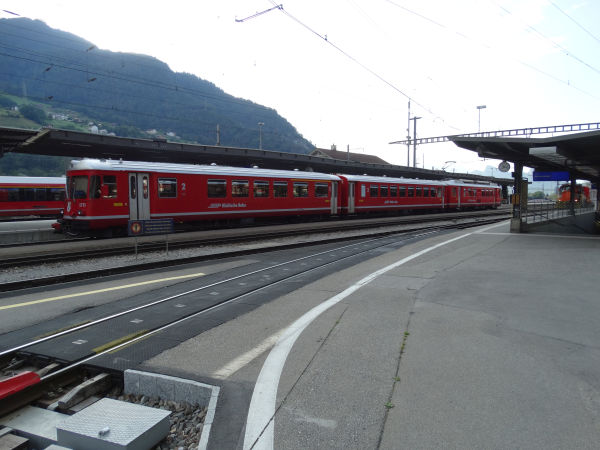
This is a classic flatland short-distance train of Rhätische Bahn. The motor wagon on the right is the Be 4/4 no 512. These motor wagons have always been
used as a combination with three or four wagons, a steering cab coach last. Here the steering cab coach was the no.1711. These Be 4/4 motor wagons were built by
FFA, SIG, and SAAS in 1971 and again in 1979 and there were six of these trains, with the motor wagons numbered 511 to 516. It is a 90 km/h fast EMU combination
mainly intended for the suburban commuter traffic around the city of Chur. These trains are technically remarcable as they are Switzerland's first thyristor
controlled electric multiple units. They are also fitted with automatic Scharfenberg couplings, which is not the normal case for RhB trains. These are
now being phased out and scrapped since 2019.
Picture from Landquart 4.7.2019 by Ilkka Siissalo.
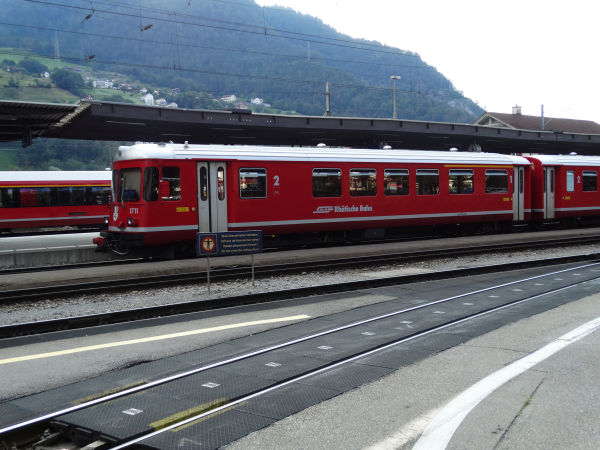
A closer view of the steering cab coach no.1711 which belonged to the same train as described above. The front of these coaches was designed to match the
nice looking face of the Re 4/4 / RhB Ge 4/4 locomotives, see above.
Picture from Landquart 4.7.2019 by Ilkka Siissalo.

A closer view of the Be 4/4 no. 512 motor wagon of the train described above.
Picture from Landquart 4.7.2019 by Ilkka Siissalo.
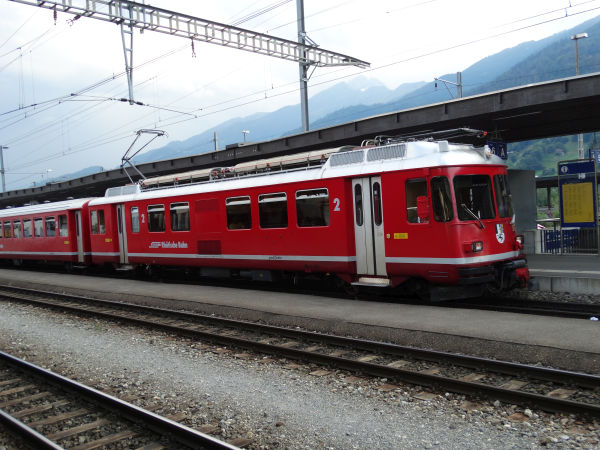
The design of the Be 4/4 no.512 motor wagon is already from the 1960s but nevertheless it looks very modern. It also very much looks the same as the
Swiss state federal railways SBB's "Mirage" trains which were the most top modern trains in the late 1960s and which were used in the commuter traffic of Zürich.
Picture from Landquart 4.7.2019 by Ilkka Siissalo.
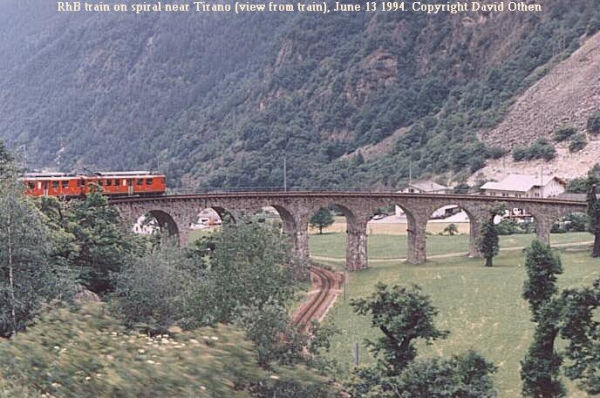
Rhaetian Railways (Rhätische Bahn) EMU units heading a Bernina Express train around the Brusio spiral near Tirano on the Swiss side of
the border with Italy, 13 June 1994.
Photo taken from train by Pat & David Othen.
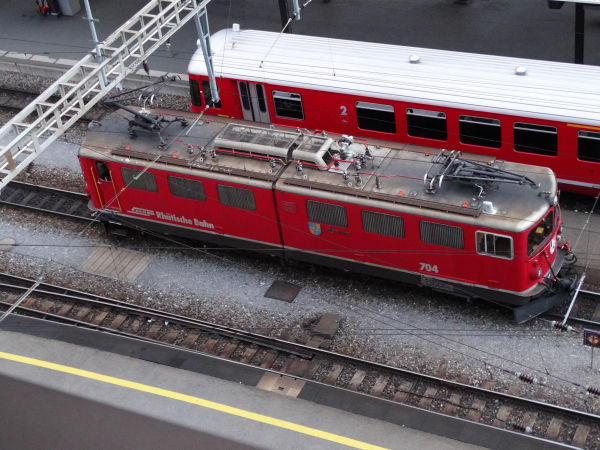
Rhätische Bahn locomotive type Ge 6/6 II is already old and it is a rarity to see one. The last ones are being pushed out of service as
we speak. It is/was a six axle machine which was able to bend in the middle. They were built 1958 and again in 1965 by a consortium of SLM, BBC
and MFO. Seven machines were made and at the time when this picture was taken, only two remained. It is a BoBoBo (2 + 2 + 2 axles) locomotive
with a very modest power otput of only 1,776 kW and a top speed of 80 km/h. The last two ones have been used mainly in cargo traffic and this picture
of a machine which just had left a passenger train was an absolute rarity in 2019.
Picture from Landquart 4.7.2019 by Ilkka Siissalo.
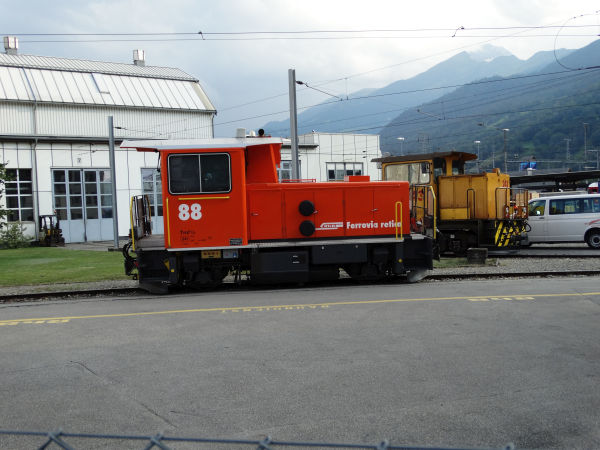
Rhätische Bahn's small switcher Tmf 2/2 no.88 is intended for switcher work at RhB's main maintenance works at Landquart. In the background
another, older switcher diesel.
Picture from Landquart 4.7.2019 by Ilkka Siissalo.
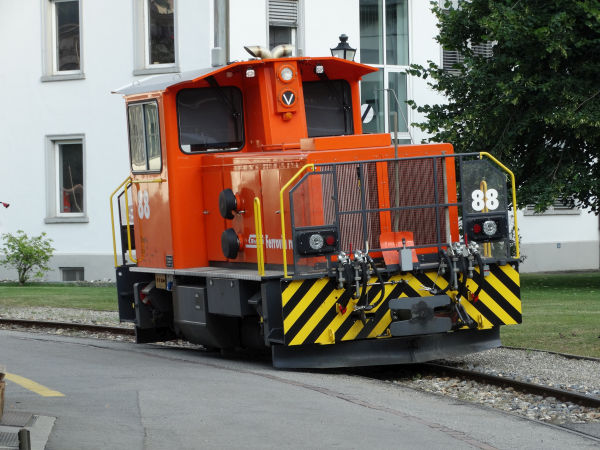
The same switcher Tmf 2/2 no.88 seen more from its front.
Picture from Landquart 4.7.2019 by Ilkka Siissalo.
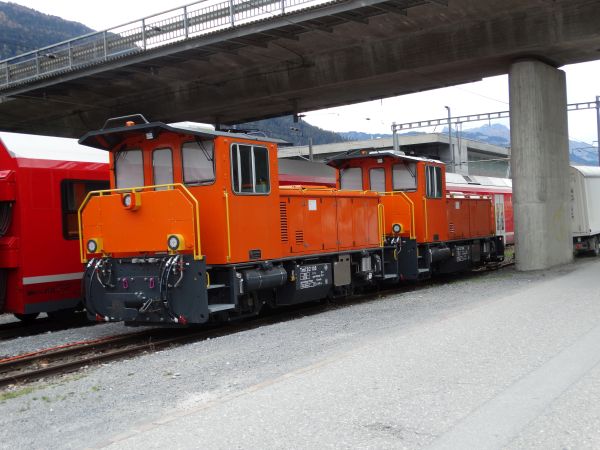
Rhätische Bahn "diesel tractors" of the type Tmf 2/2 no.104 and 105. These were first built by the company Robert Aebi (Raco) 1991 to 1994, numbers
85 to 90. When RhB then wanted to move these machines for track maintenance groups, they needed more of similar machines. Schöma built more of them, up to the
number 120 in 2006. They can be remotely controlled via radio. These weigh 24 tons and have a power rating of 336 kW and a top speed of 50 km/h.
Picture from Felsberg station 3.11.2022 by Ilkka Siissalo.
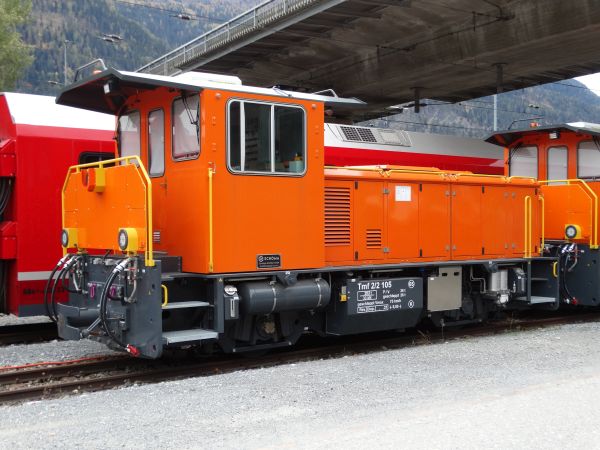
A closer look at the RhB Tmf 2/2 no.105.
Picture from Felsberg station 3.11.2022 by Ilkka Siissalo.
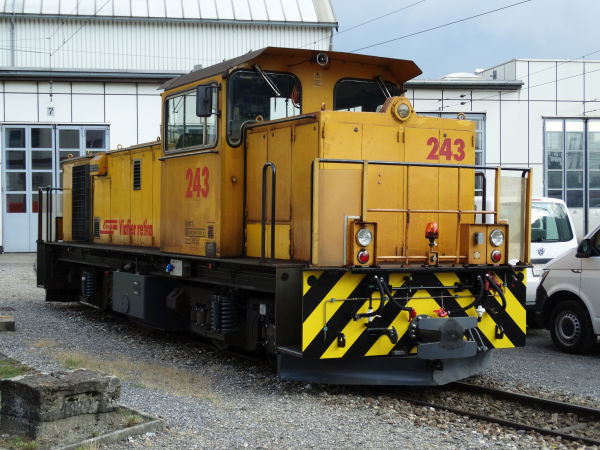
Gmf 4/4 no.243 is a dieselhydraulic switcher locomotive of the Rhätische Bahn. There are two of them, 242 and 243, and they are from the year 1991.
They were built by Kaelble-Gmeinder and they were intended for the building of the very long Vereina tunnel. These machines brought the smashed rocks
out of the tunnel. After the tunnel has been finished, one of them is on standby close to the Vereina tunnel with an emergency train ready to help in
case of an emergency and the other one is helping with various track renewal projects elsewhere.
Picture from Landquart 4.7.2019 by Ilkka Siissalo.
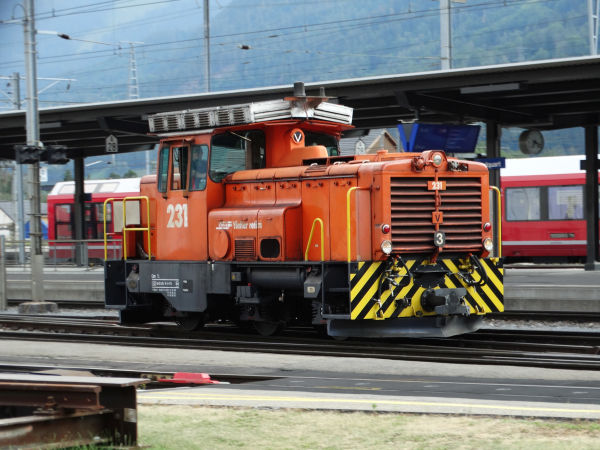
Rhätische Bahn Gm 3/3 no.231 is a three-axle shunter diesel of RhB. There were three of them with numbers 231-233 built in 1975-76 by Moyse. It has a very modest
power rating of only 386 kW with its MTU 6V 33 1 TC10 diesel engine. Top speed is 55 km/h. They are purely intended for the heavy switching work at the three
busiest cargo stations of RhB Landquart, Chur and Untervaz.
Picture from Landquart 4.7.2019 by Ilkka Siissalo.
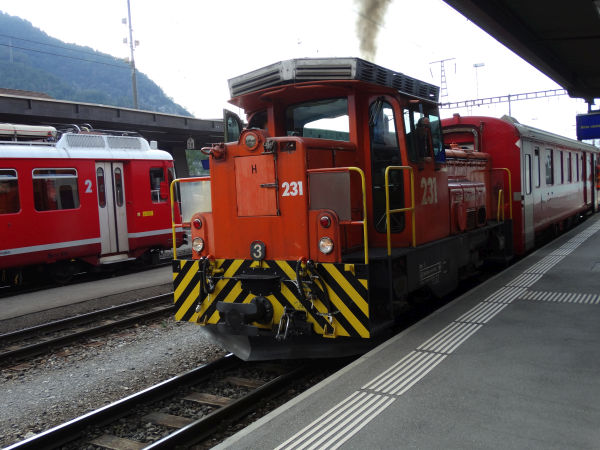
The same RhB Gm 3/3 231 as above is here fetching a steering cab coach from the platform and is causing quite a plume of smoke when accelerating.
Picture from Landquart 4.7.2019 by Ilkka Siissalo.
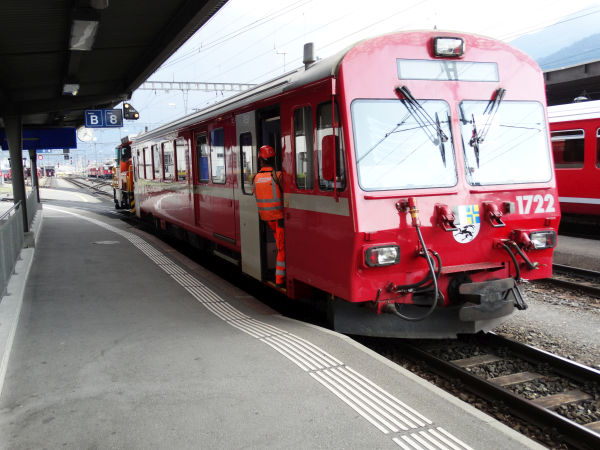
Continuation to the picture shown above... The steering cab coach no.1722 which the shunter Gm 3/3 231 was fetching is one of the most modern steering
wagons of RhB. It is mainly used in the Chur area commuter services.
Picture from Landquart 4.7.2019 by Ilkka Siissalo.
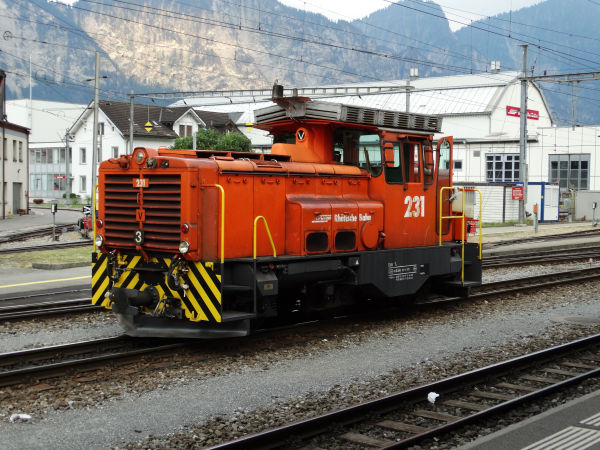
Still the same RhB Gm 3/3 231 as above.
Picture from Landquart 4.7.2019 by Ilkka Siissalo.
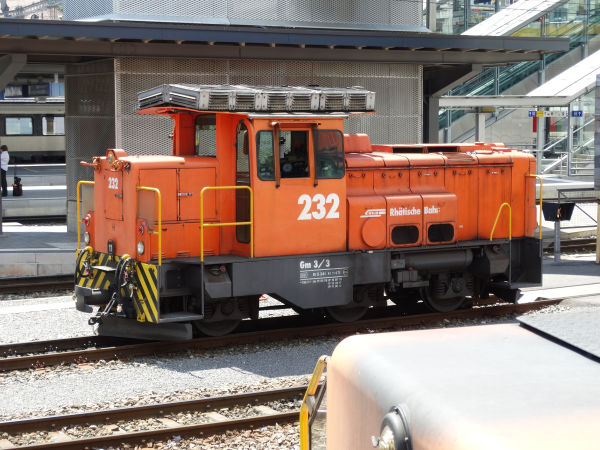
The similar Gm 3/3 no.232 was waiting for new tasks at the Chur station.
Picture from Chur 5.7.2019 by Ilkka Siissalo.

The small electric shunter locomotive Ge 3/3 no.215 was built by Robert Aebi (Raco) and BBC in 1984. There are only two of these
locomotives. No.214 is normally in Samedan and 215 in Chur.
Picture from Chur 5.7.2019 by Ilkka Siissalo.
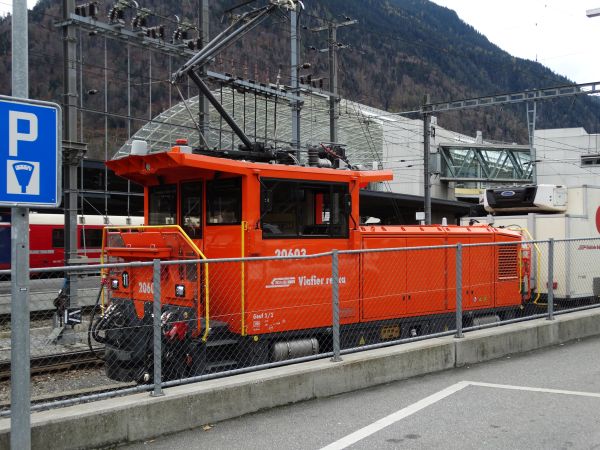
The old electric shunter 215 shown above has now been replaced. This is the new locomotive which has taken its place. This is Geaf 2/2
no.20602. This new one is a hybrid, it can operate also on tracks with no catenary wires. This one has been built by Stadler.
Picture from Chur 3.11.2022 by Ilkka Siissalo.
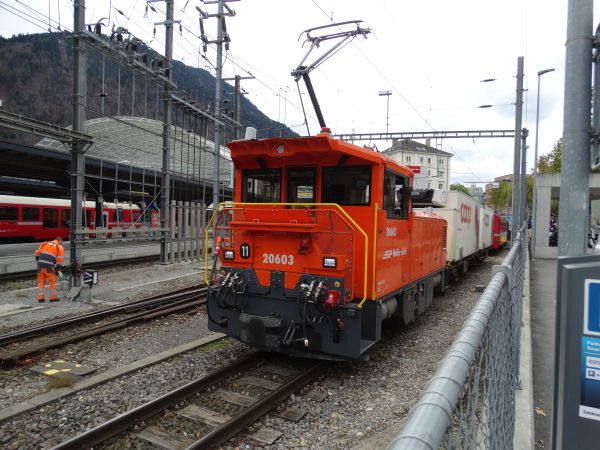
The same new Geaf 2/2 no.20602 seen from another direction (and over the fence). Matterhorn-Gotthardbahn MGB has bought a similar new shunter.
They call the type Tea 2/2 (T=tractor, e=electric, a=accu)
Picture from Chur 3.11.2022 by Ilkka Siissalo.
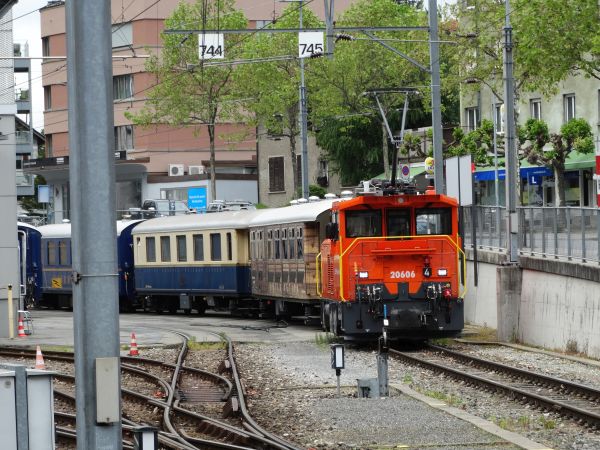
A similar Geaf 2/2 no.20606 is doing shunting work with very old special wagons which are used in superexpensive charter trains.
Picture from Chur 14.5.2023 by Ilkka Siissalo.
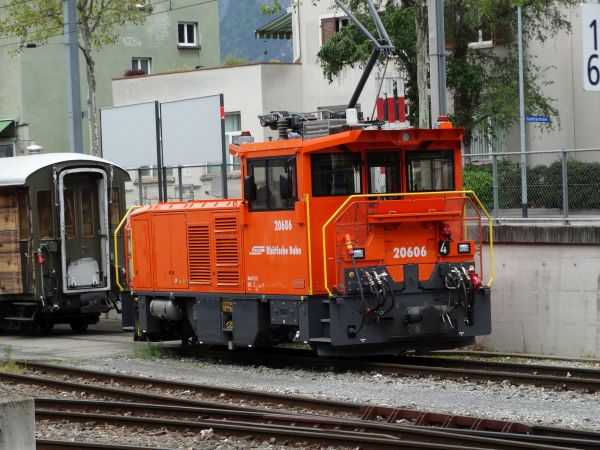
A closer look at the new Geaf 2/2 no.20606.
Picture from Chur 14.5.2023 by Ilkka Siissalo.
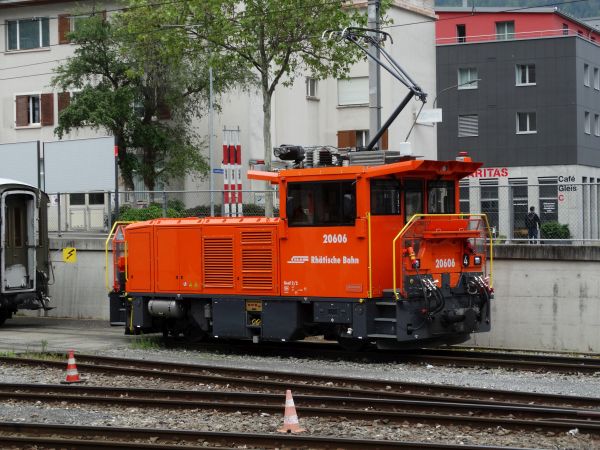
...and still a full side view of the new Geaf 2/2 no.20606.
Picture from Chur 14.5.2023 by Ilkka Siissalo.
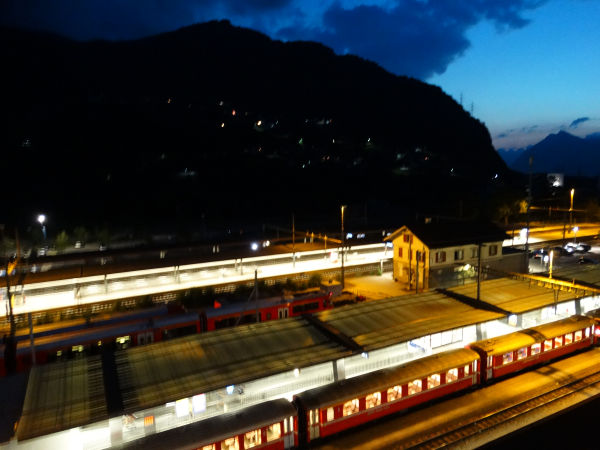
Landquart station during nighttime and seen from a hotel room just next to it. In the front an old-fashioned RhB express train from
Davos and in the track behind a more modern Allegra EMU..
Picture from Landquart 4.7.2019 by Ilkka Siissalo.
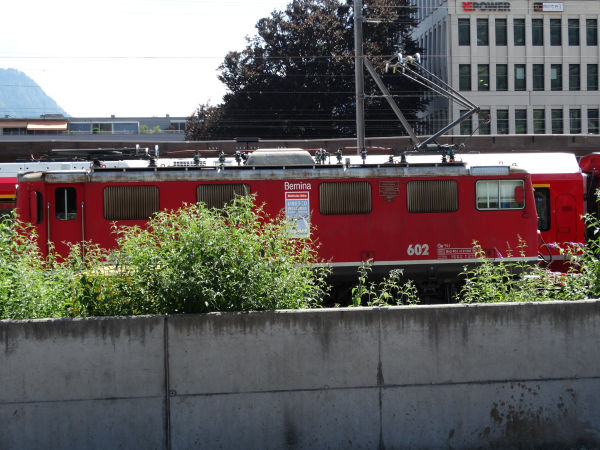
Sorry that this picture is taken from through the bushes, but we were lucky to see even this much. This locomotive is the Ge 4/4 I no.602.
These machines were built in 1947 and the last ones in 1953 and they have already for a long time been supposed to be dead and scrapped, but still one
or two machines seemed miraculously to have lived over to the year 2019 and this is one. Ten machines were made and their scrapping has been
going on already since 2010. It is an 80 km/h fast four-axle locomotive. This one, no.602 "Bernina" is now the property of the Swiss transport museum
"Verkehrshaus" from Luzern since already 2012, but to our big surprise, there it still stood at the Landquart station, but well hidden.
Picture from Landquart 5.7.2019 by Ilkka Siissalo.
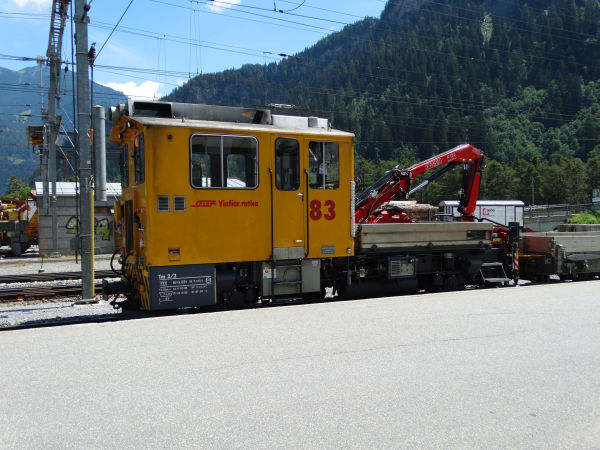
A Rhätische Bahn rail truck of the class Tm 2/2 no.83. This is a metre gauge machine built by the company Robert Aebi. This one was built in 1985 and
it is permanently stationed at Thusis.
Picture from the station of Thusis 5.7.2019 by Ilkka Siissalo.
Verein Dampffreunde der Rhätischen Bahn - Association of friends of steam locomotives of RhB
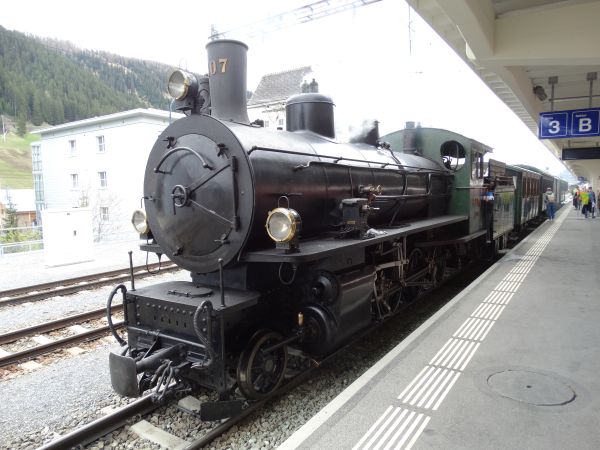
Locomotive G 4/5 no.107 "Albula" from the year 1909. The G 4/5 locomotives were the longest series of locomotives ever built for RhB: 29 machines were built
in several series, After the RhB lines were electrified many of these were sold abroad while they were still relatively young. For eaxmple the Royal State
Railways of Siam (now Thailand) bought 18 machines in the late 1920s and kept using them until the late 1980s. Many of these also ended up in Spain. Two of
these locomotives have been kept in good working order by the association Friends of steam locomotives of Rhätische Bahn. They are named Albula and Engiadina.
On 14.5.2023 the association Dampffrreunde der Rhätischen Bahn arranged two steam locomotive powered special museum train runs between Davos Dorf and Landquart.
Picture from Davos Dorf 14.5.2023 by Ilkka Siissalo.
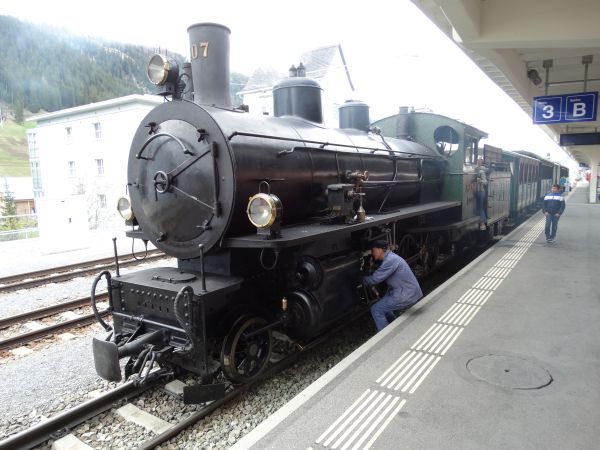
Taking good care of a steam locomotive requires a lot of oiling and greasing.
Picture from Davos Dorf 14.5.2023 by Ilkka Siissalo.
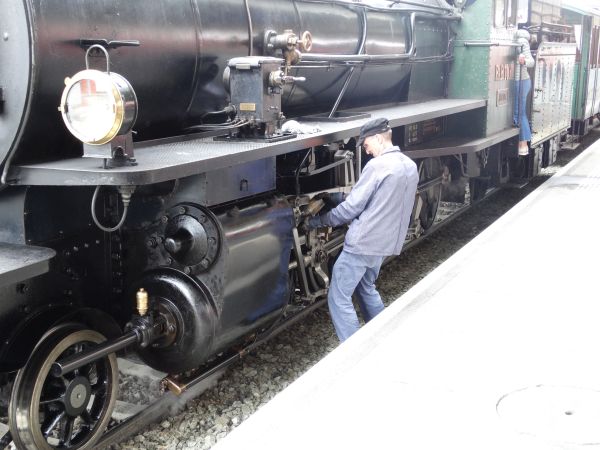
Oiling is ongoing...
Picture from Davos Dorf 14.5.2023 by Ilkka Siissalo.
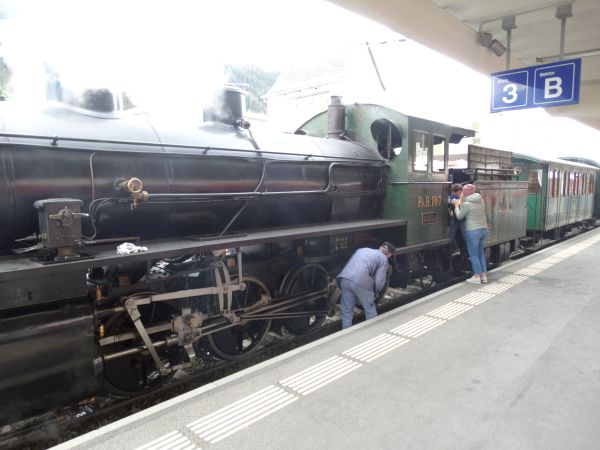
Still some last checks... In the meantime a young mother got the permission to lift her boy up in the locomotive to see it properly.
Here the boy was reluctant to be lifted back down to the ground.
Picture from Davos Dorf 14.5.2023 by Ilkka Siissalo.
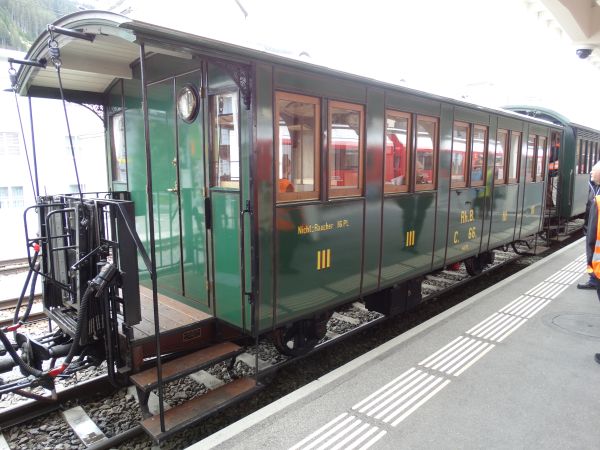
The whole museum train consisted of fantastic old wagons. This third class wagon C66 is from the year 1897, yet it looked like brand new.
This one is owned by the club "Club 1889" based in Samedan. The wagon had been restored to original condition during the years 2015-2021.
Picture from Davos Dorf 14.5.2023 by Ilkka Siissalo.
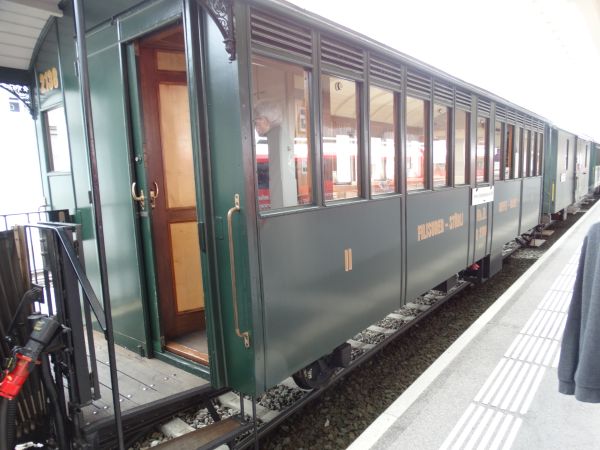
The wagon B 2138 "Filisurer Stübli" was a workers' canteen wagon used when the Rhätische Bahn main line was being built through the very difficult
terrain. This canteen wagon is still owned by the company RhB. It has now been taken good care of by the club "Club 1889". The wagon is from the year
1903.
Picture from Davos Dorf 14.5.2023 by Ilkka Siissalo.
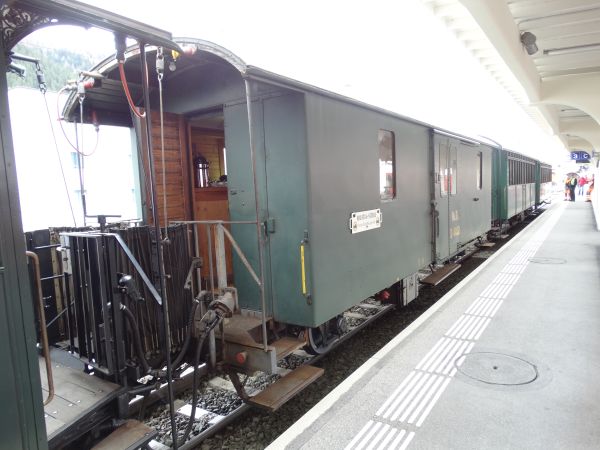
The wagon D 4952 was once a baggage and cargo wagon used on RhB's Engadinerlinie line. It is from 1913. Its official classification is RhB D2 4052 II.
Since 1999 it is now a barwagon and the club's meeting place for the club Dampffreunde der Rhätischen Bahn. Putting this wagon back in working order took
435 working hours by the club "Club 1889". It has now since 2003 been property of the association Dampffreunde der Rhätischen Bahn. The beer bar has been
named "Marcello-Bar" in recognition to the late charismatic leader of the association Verein Dampffreunde der Rhätischen Bahn. The whole wagon has now gotten
the name "RHÆTIA-StÛBLI".
Picture from Davos Dorf 14.5.2023 by Ilkka Siissalo.
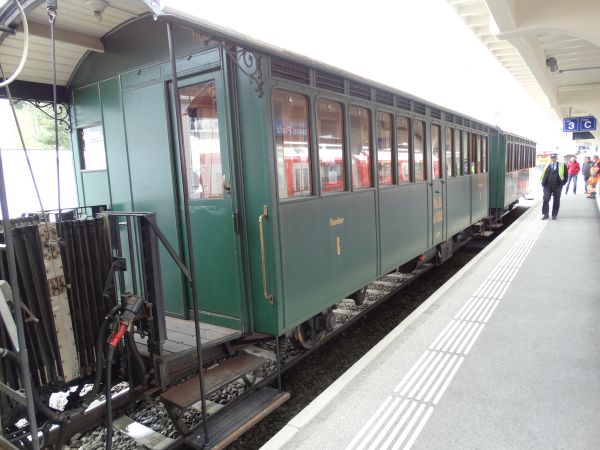
The wagon A 1102 is a first class passenger wagon from the year 1903. It went through a major revision in Landquart in 2017-2018.
It has been taken care of by the association Verein pro Salonwagen RhB.
Picture from Davos Dorf 14.5.2023 by Ilkka Siissalo.

Last but not least, this was the wagon B 2060, a second class passenger wagon from the year 1906.
Picture from Davos Dorf 14.5.2023 by Ilkka Siissalo.
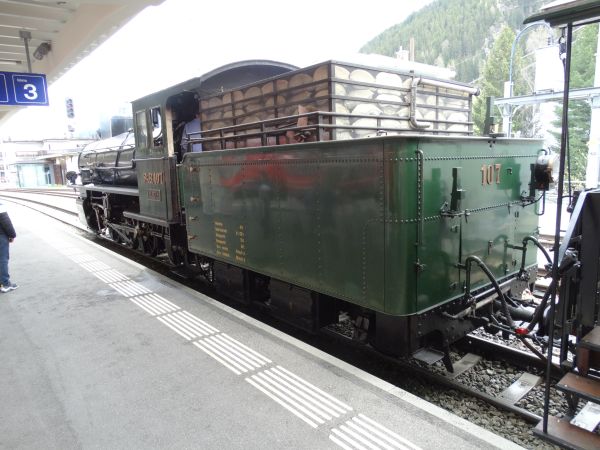
Still a view of the locomotive G 4/5 no.107 from behind. Note that the "wood logs" on the tender wagon are just fakes, printed pictures.
In reality the locomotive seems to be using heating oil as its fuel now.
Picture from Davos Dorf 14.5.2023 by Ilkka Siissalo.
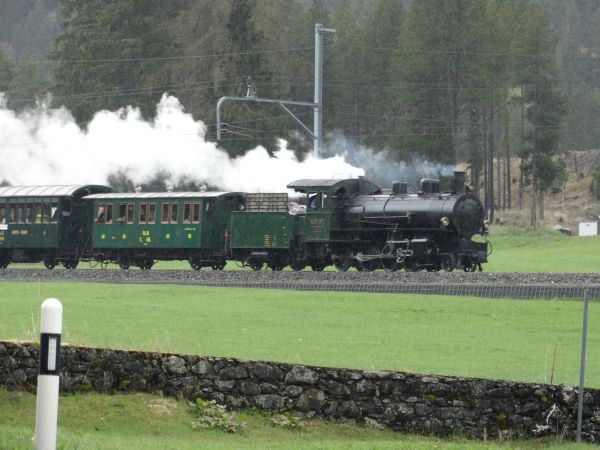
There the museum train goes now towards Landquart. Note how only very little smoke comes out of the chimney as the machine is apparently now
fueled with light oil, but a lot of water vapour comes out of a separate smaller tube just in front of the cabin from the "smoke box" of the locomotive.
Picture from a bus stop called Ober Laret close to Davos 14.5.2023 by Ilkka Siissalo.
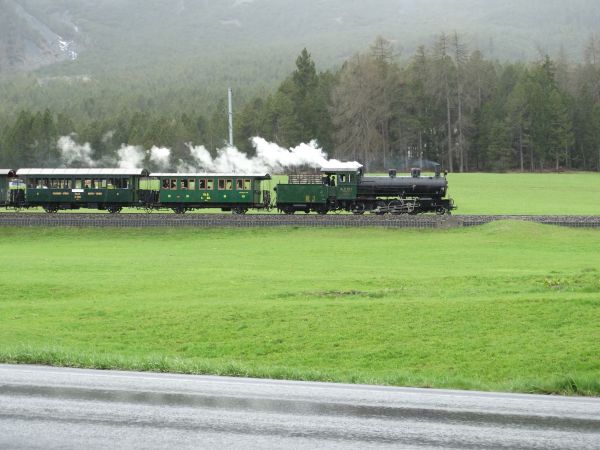
The museum train just passing the bus stop Ober Laret near Davos.
Picture from a bus stop called Ober Laret close to Davos 14.5.2023 by Ilkka Siissalo.
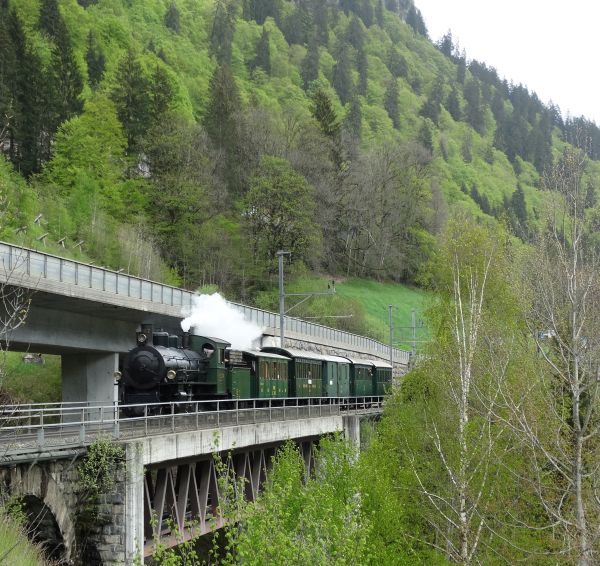
The museum train is crossing a bridge near Serneus.
Picture from Serneus close to Klosters 14.5.2023 by Ilkka Siissalo.

